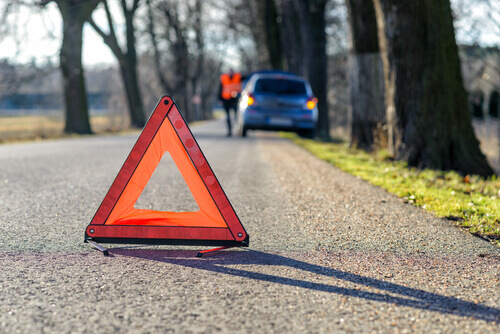What You Should Do If You Have A Tire Blowout
Posted on
Few things are as frightening as experiencing a tire blowout during your drive. All kinds of problems can occur in the aftermath of that blowout.
It jeopardizes the safety of everyone in your vehicle, and it’s not that difficult to imagine how bad things can go in that situation.
To keep yourself and everyone who rides in your car safe, you need to know more about tire blowouts. In this article, we’ll talk about the causes and the signs of a tire blowout. We’ll also discuss how you should react if you experience this issue and how you can avoid it moving forward.
Without further ado, let’s start learning more about tire blowouts.
What Causes Tire Blowouts?
Your tire blowing is not a random occurrence. It can happen for a variety of reasons, including ones you cannot control and those that you can avoid with due diligence. Being mindful of the potential causes of a tire blowout is crucial if you want to avoid being in a car accident or any other unfortunate incidents. Detailed below are those potential causes.
Your Tires Are Underinflated
Tires losing air is natural. Constantly using your car will lead to your tires losing air gradually. If you live in an area with a colder climate, your tires are more likely to lose air pressure at a faster rate.
Damaged tires are also more susceptible to losing air and becoming underinflated.
The main issue here is that the lack of air pressure can cause the internal components of the tire to become warped. Once this happens, it will only be a matter of time before it compromises the strength and durability.
Not long after that, you will have a tire blowout on your hands.
Underinflation can also happen because of how you maintain your tires. Out of caution, you may have been too light on the air when you were re-inflating your tires. That miscalculation can prove costly.
Your Tires Are Taking a Beating from Road Hazards
While we would all prefer to drive on smooth and flawless roads, the reality is that most of us don’t have that luxury since many across the country have formed potholes.
It probably comes as no surprise that your tires snagging on a pothole is not a good thing. The impact of hitting the hole can damage the tire’s internal components and cause a full blowout on its own.
Beyond potholes, you should also be mindful of other road hazards that can hit your tires hard. Anything solid that gets in the way of your tires while driving can be the possible cause of a blowout.
Your Tires Support an Excessively Heavy Load
Overloading is a mistake more than a few car owners make. If you’re going on vacation or moving, you may pack way too much in your vehicle, thinking that it can handle the burden with no problem.
Of course, vehicles don’t work that way. The excessive amount of pressure caused by overloading will cause damage to the tires. The tires blowing out is a possibility at that point.
Your Tires Are Worn Down
Tire blowouts don’t always happen because of a sudden and unexpected event. They could also be the result of accumulated punishment that your tires have endured.
Consistently underinflating your tires, overloading your vehicle, or running into road hazards can take a real toll. Sooner or later, those incidents will catch up to you unless you do something about your tires beforehand.
What Are the Risk Factors for Tire Blowouts?

After reading about the common causes of tire blowouts above, you’ve probably guessed that overall negligence on the part of the vehicle owner is one of the primary risk factors. If you do not pay close attention to car care, there’s a greater chance that you will suffer a blowout in the future.
Apart from negligence, the weather outside can also be a contributing factor. As noted by Popular Mechanics, people are more likely to suffer tire blowouts from the middle of May up to early October because of the warmer weather.
The issue is not with the weather itself.
Instead, it’s the fact that more people are driving fully loaded vehicles greater distances during that time of the year for vacation purposes that causes the uptick in blowouts. Your tires are taking on even more punishment during that time, and they become more susceptible to blowouts as a result.
What Are the Signs of a Tire Blowout?
You should get a feel for a tire blowout as it occurs.
The first thing you should notice is a disruption in the car’s normal movements. You expect the car to be moving along without issue over the road, but a blowout can change that. You may start to feel a thumping sensation emanating from one side of the vehicle.
Suddenly, you may also feel the tire go flat. You’ve probably dealt with flat tires before, so you may be familiar with that sensation.
The next sign of trouble is your car pulling in one specific direction. Most likely, that’s your car losing equilibrium as it leans towards the side of the blown-out tire.
How to Handle a Tire Blowout
The reason why tire blowouts lead to worse accidents is because drivers make some simple mistakes. They get caught up in the moment, panic, and do things that cause them to lose control of the vehicle even further.
It’s important to remember that you can still maintain control over your vehicle even in the event of a tire blowout. Follow the steps detailed below so that you can manage that incident properly and get off the road safely.
Step 1: Maintain Control
One of the worst things you can do right after a tire blowout is to give up control of the vehicle. Doing so is probably going to lead to an accident.
What you want to do instead is to keep your hands on the wheel and maintain control. That is an essential part of managing this situation. Keep your hands steady and be ready to react.
Step 2: Accelerate Lightly
Accelerating when one of your tires blows may seem like lunacy, but it’s a safe move for you to make. Accelerating in that situation helps stabilize your vehicle. The acceleration will make it easier to keep going straight as opposed to wobbling from side to side and potentially causing an accident.
Step 3: Warn the Vehicles around You
Turn on your hazard lights now and let the drivers around you know that you’re experiencing car trouble. This is important because you’ll be pulling over soon, and you’ll need some room to maneuver.
Step 4: Wait for Your Vehicle to Slow Down
That blown out tire will prevent you from gaining good traction. You’ll have a hard time accelerating properly with that tire slowing you down. Because of that, you allow the tire to aid in your vehicle’s deceleration.
It may seem like it’s taking forever, but the reality is that your vehicle will slow down in seconds after a tire blowout. Continue moving straight ahead until such time that your vehicle’s speed is around 20 mph, according to Firestone. Once your vehicle slows down to that level, you can start moving towards the side of the road.
Step 5: Step on the Brakes after Getting Off the Road
You’ve probably noticed that we haven’t mentioned anything about braking before right now. That’s not a mistake.
Hitting the brakes right after your tire blows is a way to lose control over your car. Since you’re still moving fast, hitting the brake could lead to your vehicle careening out of control.
The only time you should touch the brakes is after your car’s speed goes down to 20 mph, as we mentioned earlier. Even then, you should only stop your vehicle once you’re off the road.
Step 6: Replace Your Tire Yourself or Call for Assistance
Hopefully, you have a spare tire on hand, and you can replace it on your own. If you don’t have a spare tire or aren<‘t too confident on your own, contact roadside assistance right away. Stay with your vehicle while waiting for help to arrive, and don’t try to drive it until it’s repaired.
What Should You Do if a Tire Blowout Causes an Accident?
Let’s say that a driver in front of you couldn’t keep their cool after their tire blew; they slammed down on their brakes and hit your car. It’s unfortunate, but that is a possibility.
Now that an accident has taken place, the first thing you should do is assess yourself and your passengers for injuries. Next, move your vehicle if it’s in the middle of the road.
You should now check on the people in the other vehicle and see if they are injured. Contact emergency services right away if someone is injured. Even if no one is hurt, you should still contact the police.
Keep an eye on the other driver and make sure that they remain on the scene. You should also take this opportunity to gather personal information from the other driver, take pictures of the accident site, and talk to witnesses if there are any.
Wait for the police and follow their instructions regarding how to proceed. You should also remember to get the names and badge numbers of the police officers so that you can contact them later.
How Can You Avoid a Tire Blowout?

Tire blowouts are not inevitable. Taking some precautionary measures will help greatly. Check out those precautionary measures below.
Be More Diligent When It Comes to Tire Care
Remember how we discussed earlier that underinflating your tires and overloading your car are among the main causes of blowouts? Those problems stem from poor tire maintenance.
A good tip to keep in mind here is to follow the owner’s manual for your tires. That manual will usually indicate the recommended tire pressure. Listen to what the manufacturers are saying because doing so will be best for your vehicle.
You should also look for your car’s gross vehicular weight rating. Factors that number into your calculations whenever you’re trying to determine if your car can handle the load you want it to carry.
It’s also a good idea to perform regular checks on your tire pressure. Purchase a pressure gauge and use that to keep track of where your tires are at before hitting the road
Be More Cautious while Driving
Sustained damage from running into obstacles can do a number on your tires. Try to limit the damage as much as you can by being more cautious on the road.
Avoid driving at high speeds and possibly allowing a pothole to deal significant damage to your tires. You can also avoid other road hazards by driving more carefully. Maintain those habits going forward, and your tires should remain in better shape longer.
Avoid Driving on Worn Down Tires
One more thing you can do to avoid blowouts is to refrain from driving with worn-down tires because they are susceptible to blowing out.
As soon as you suspect that your tires are no longer in prime condition, take them to an auto shop to be checked. If replacing them is necessary, then so be it. That’s certainly preferable to suffering a sudden blowout.
Tire blowouts are potential causes of accidents. If another driver’s blowout does damage to your vehicle, be ready to take legal action. We at the Saeedian Law Group will help ensure that you get fair compensation following the accident. Contact us today so we can start working on your case.

